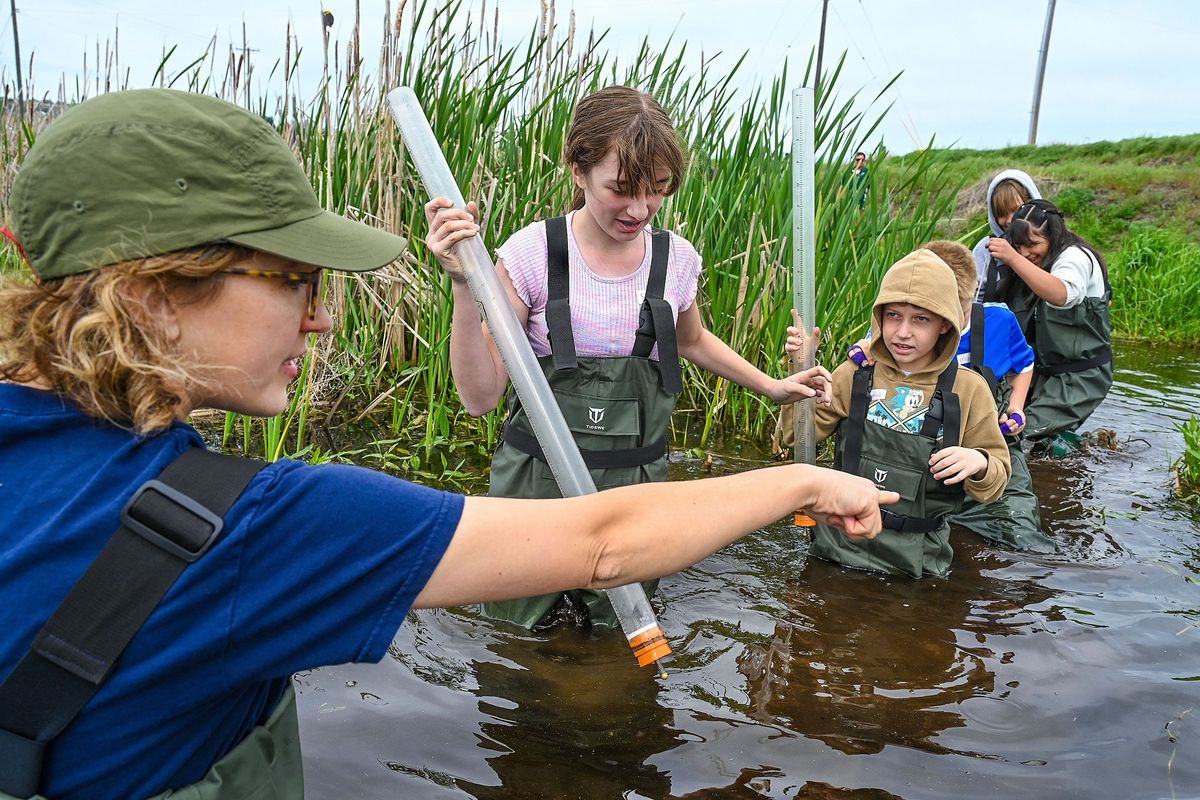‘This is the magical land’: Students from Central, East Valley visit Saltese Flats in scientific field trip
Laura Goff, water resources educator, directs Trent Elementary School fifth-graders Sky Johnson and Daniel Topov into position as they wade into the waters of Saltese Flats while conducting observation studying of water clarity and temperature Thursday at the Doris Morrison Learning Center on South Henry Road. Central Valley and East Valley school districts are participating in the Wetland Explorers Field Trip program. (DAN PELLE/THE SPOKESMAN-REVIEW)
In the late 1800s, Bud Morrison’s grandfather drained Saltese Lake, providing a fertile acreage under the looming Mica Peak to homestead, growing hay and raising cattle.
Once one of the largest ranches in the county, the Morrison patriarch may not recognize the 300-acre section of land his family sold in 2010 to the county, which is now in the midst of restoring the wetlands.
Peering out over the marsh is the Doris Morrison Learning Center, a condition of the sale. The visitor’s center is named for Bud’s mother, a school teacher who lived to be 103 on the Greenacres ranch.
Stampeding into Doris’ legacy on Thursday were more than 100 fifth-graders from East Valley schools, eager to get their hands dirty in Spokane County’s wetland explorers field trip program.
Watching the kids clamor in, it’s everything Bud could have wanted. He’s emotional thinking of his kindhearted mother, a teacher well into her golden years.
“She’s looking down,” he said. “She would say, ‘I didn’t deserve that.’ ”
The grant-funded program lasts seven weeks; every fifth-grader from Central and East Valley school districts visited the park in that time, more than 1,500 total.
“Getting these kids outside is really important, because who knows what kind of opportunities they may or may not have to do so in other areas of their life?” Water Resources Program manager Nicki Feiten said.
“Getting that field science in the hands of them at an age that might spark an interest for their futures,” she said .
Feiten became a biologist because of a fifth-grade field trip to a county park in her home state of Wisconsin.
“That’s stuck with me forever,” Feiten said.
Funded through a $75,000 “no child left inside” grant from the state Recreation and Conservation office, kids wore waders and trudged through the marsh to test water quality, peaked at macroinvertebrates through microscopes and spied on birds with binoculars, learning about the water and ecosystem of Saltese Flats, 1,200 acres of restored wetland south of Greenacres.
The grant paid for the child-sized gear, along with training and curriculum for more than 50 teachers in the districts. While the field trips through the county will only last two years, teachers are trained with the intention that they may lead their own field trips at Saltese Flats. Gear purchased with the grant will be available at the center for teachers to borrow for these field trips.
Trent Elementary School fifth graders view bugs with microscopes near the waters of Saltese Flats Thursday, May 16, 2024, at the Doris Morrison Learning Center on South Henry Road in Spokane County. Central Valley and East Valley School Districts are participating in the Wetland Explorers Field Trip program. (DAN PELLE/THE SPOKESMAN-REVIEW)
Running the macroinvertebrates section, educational water resource specialist RaeAnn Nolander guides students in using microscopes to identify nymphs, snails and other tiny aquatic life.
“In this lesson, we talk about bugs and things that are creepy that they would normally just smash without even really thinking about it,” Nolander said. “And then suddenly they’re thinking, ‘What if you were this little, how would you like to be treated in this pipette?’ ”
Some students recoil in disgust and terror at the microscopic critters. Curiosity supersedes fear in many, and in a couple of minutes, using pipettes to collect the bugs and place them on microscope slides is the highlight of the day, as is the case for bug fan Alex Velazquez.
“I was the kind of person to just look around in concrete and find ants and pick them up,” Alex said, as Trent Elementary classmate Skylar Johnson squealed and jumped away from a microscope zoomed in on an isopod.
“That thing scared me,” Skylar said, though fear didn’t stop her from loading another critter on the microscope slide and taking a peek.
Otis Orchards student Matthew Kirichenko peered through binoculars to watch yellow-headed blackbirds spar through the reeds with their natural foe, the red-winged blackbird.
The marsh is alive with avian activity. He even caught a glimpse of a beaver diving into the swamp. He’s no stranger to nature; the avid outdoorsman hunts, fishes, builds structures and practices his survival skills on his family’s farm with his brother.
“It makes me free,” Matthew said of spending time outside. “What I like to do is go to my hunting place; that’s what I like to do outside … better than sitting in a chair and playing those video games. That’s what I don’t like.”
Educators hope the hands-on experience instills in the young scholars the importance of healthy stewardship of the natural world.
In seeing the active restoration of Saltese Flats, they learn progress is in their hands as much as environmental degradation.
“We have this water here because we’re restoring it,” said Laura Goff, educational water resource specialist. “We can damage the environment – we can also bring it back. We can restore it. We can be positive agents in our community.”







